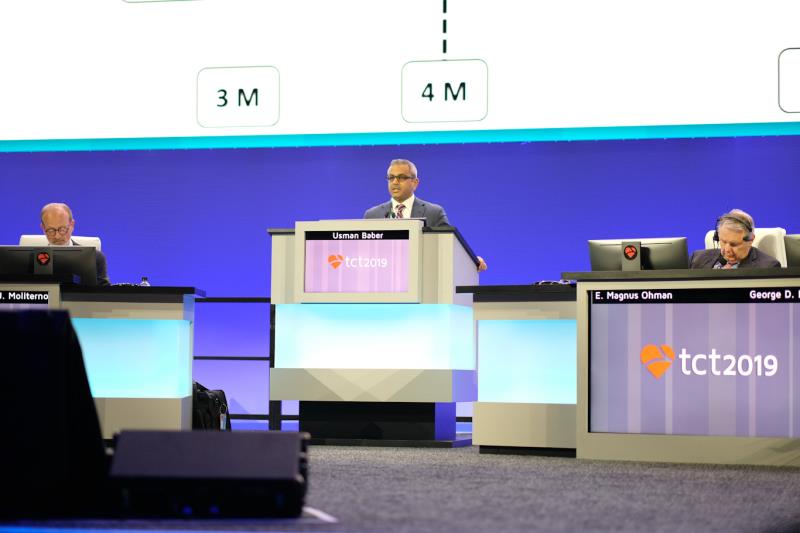 Dr Usman Baber
Dr Usman BaberThe antithrombotic potency of ticagrelor alone on ex vivo whole blood thrombogenicity does not differ from that of ticagrelor plus aspirin in high-risk patients who have undergone percutaneous coronary intervention (PCI), according to the thrombogenicity substudy of the TWILIGHT* trial.
“Ticagrelor monotherapy provides a similar antithrombotic effect to that of ticagrelor plus aspirin as assessed by ex vivo platelet-dependent thrombus formation,” said Assistant Professor Usman Baber from the Icahn School of Medicine at Mount Sinai, New York, US, who presented the findings at TCT 2019.
Participants in the TWILIGHT trial were 9,006 high-risk patients who had undergone PCI with drug-eluting stents and who had received a dual antiplatelet therapy (DAPT) regimen of ticagrelor plus aspirin for 3 months. At 3 months, event-free individuals were randomized to receive ticagrelor alone or ticagrelor plus aspirin. Of these, 51 patients** were selected for the substudy and underwent perfusion assay and platelet aggregation at randomization and after 1 month (n=23 and 28 on ticagrelor alone and ticagrelor plus aspirin, respectively).
Eighteen patients assigned to ticagrelor alone (mean age 61.9 years, 11.1 percent female, 27.8 percent with diabetes mellitus, 11.1 percent current smokers) and 24 assigned to ticagrelor plus aspirin (mean age 64.6 years, 12.5 percent female, 41.7 percent with diabetes mellitus, 20.8 percent current smokers) completed follow-up, with repeat assessments at 1–6 months.
There was no difference in change in ex vivo platelet-dependent thrombus area between patients who received ticagrelor alone and ticagrelor plus aspirin (mean between-group difference, 218.2 μm2; p=0.22). [TCT 2019, Late-Breaking Science 1]
There was also no difference within each group between baseline and follow-up in terms of thrombus area (from 3130.7 to 3152.4 μm2; p=0.87 in the ticagrelor alone group and from 3741.5 to 3903.8 μm2; p=0.16 in the ticagrelor plus aspirin group).
“These findings suggest that aspirin withdrawal does not modulate ex vivo blood thrombogenicity in the presence of strong P2Y12 blockade with ticagrelor and corroborates the clinical observations of no incremental ischaemic risk upon aspirin withdrawal seen in TWILIGHT,” said Baber.
Platelet reactivity to arachidonic acid was higher among patients on ticagrelor alone compared with ticagrelor plus aspirin (19.4 vs 11.6 U; p=0.02), as was platelet reactivity to collagen (40.2 vs 35.9 U; p=0.03). In contrast, there was no apparent difference between ticagrelor alone and ticagrelor plus aspirin recipients with regard to platelet reactivity to adenosine diphosphate (ADP; 13 vs 16.8 U; p=0.47) or thrombin receptor activating peptide-6 (77 vs 79.1 U; p=0.81).
“Platelet reactivity to collagen and arachidonic acid is increased in the absence of aspirin while aggregation to ADP and thrombin is unchanged in the presence of ticagrelor with or without aspirin,” explained Baber.
Baber pointed out that these findings apply only to ticagrelor, and the impact of other P2Y12 inhibitors such as prasugrel or clopidogrel on thrombogenicity remains to be seen. He also noted that assessment of these outcomes earlier in the DAPT regimen may have produced different results.